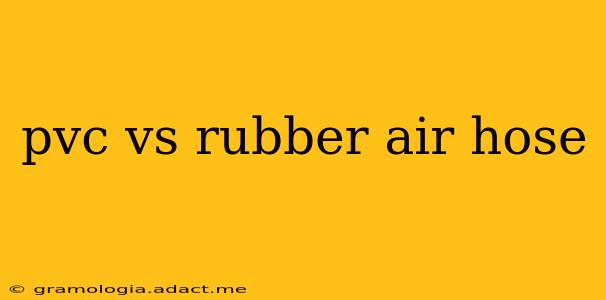Choosing the right air hose can significantly impact your productivity and safety. Two popular choices are PVC and rubber air hoses, each with its own strengths and weaknesses. This comprehensive guide will help you understand the key differences between PVC and rubber air hoses, enabling you to make an informed decision based on your specific application.
What are the key differences between PVC and rubber air hoses?
The primary differences lie in their material composition, resulting in varying levels of flexibility, durability, and resistance to chemicals and temperature extremes. PVC (polyvinyl chloride) hoses are generally lighter, more flexible, and less expensive than rubber hoses. However, rubber hoses often boast superior durability and resistance to harsh conditions.
How do PVC and rubber air hoses compare in terms of durability?
Rubber air hoses are renowned for their exceptional durability. The natural elasticity of rubber allows it to withstand significant wear and tear, making it ideal for demanding applications and rough handling. They’re less prone to kinking and are better able to handle impacts and abrasions. This translates to a longer lifespan, potentially saving you money in the long run.
PVC air hoses, while lighter and more flexible, are less durable than rubber hoses. They are more susceptible to damage from punctures, abrasions, and extreme temperatures. While suitable for many applications, they might not withstand the rigors of heavy-duty industrial use or exposure to harsh environments.
Which type of air hose is more resistant to chemicals and oils?
Rubber air hoses generally offer better resistance to a wider range of chemicals and oils compared to PVC hoses. Specific rubber compounds can be formulated to resist specific chemicals, making them suitable for use in environments with exposure to fuels, solvents, or other corrosive substances.
PVC air hoses can be susceptible to degradation when exposed to certain chemicals and oils, potentially leading to cracking, swelling, or weakening of the hose. Therefore, carefully check the manufacturer's specifications to ensure compatibility with the chemicals your application involves.
What are the temperature ranges for PVC and rubber air hoses?
Rubber air hoses generally exhibit better performance across a wider temperature range. Some specialized rubber compounds can handle both extremely hot and extremely cold temperatures.
PVC air hoses usually have a more limited operational temperature range. Exposure to extreme heat can soften and weaken the PVC, while extreme cold can make it brittle and prone to cracking.
Which air hose is lighter and more flexible?
PVC air hoses are significantly lighter and more flexible than their rubber counterparts. This makes them easier to handle and maneuver, especially in applications requiring frequent movement or reaching awkward areas. Their lighter weight also reduces operator fatigue during prolonged use.
Rubber air hoses, due to their thicker and denser construction, are heavier and less flexible. While this contributes to their durability, it can make them more cumbersome to handle in certain situations.
Are there any specific applications where one type of hose is better suited than the other?
Yes, absolutely. The choice between PVC and rubber air hoses depends heavily on the specific application.
-
PVC hoses are well-suited for lighter-duty applications, such as inflating car tires, hobbyist projects, or general-purpose use where flexibility and lightweight are prioritized.
-
Rubber hoses are the preferred choice for heavy-duty industrial applications, construction work, or environments with exposure to chemicals, oils, or extreme temperatures. Their superior durability and resistance make them a safer and more cost-effective choice in the long run for such tasks.
Ultimately, selecting the right air hose requires carefully weighing the advantages and disadvantages of each material based on your individual needs and working conditions. Consider the demands of your application, the environment, and the potential risks before making your decision.
